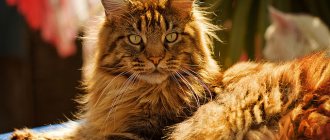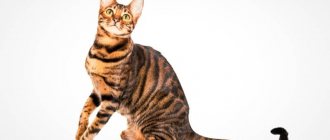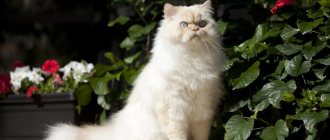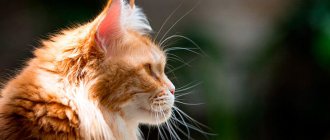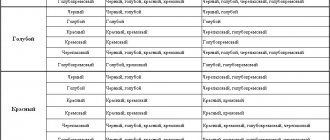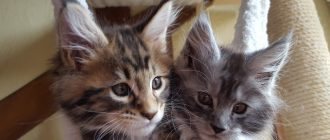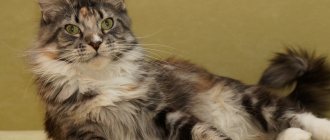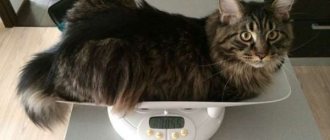Video
* We invite you to watch a video about the Maine Coon . In fact, in front of you is a playlist in which you can select and watch any of 20 videos about a given cat breed by simply clicking on the button in the upper right corner of the window. In addition, the material contains quite a lot of photos. By looking at them you can find out what a Maine Coon looks like.
In this article:
|
Rate the material!
[Total votes: 5 Average: 3.6]
How to choose and buy a Maine Coon kitten
Before you get this animal, think about the fact that it vitally needs a large area. In a small apartment, a giant will quickly get bored, especially if the owner is away all day. Only keeping two individuals at once will help relieve them of boredom.
They have a high ability to get along with other felines, and even dogs. By their nature, they do not like to fight at all, and therefore they strive to leave the conflict zone and avoid a fight.
The popularity of this breed has its downsides. Unscrupulous people often misrepresent large and furry, but out-of-breed kittens as kittens of the required breed. Therefore, it is important not to buy an animal from someone else. You should not purchase kittens that have not reached 3 months of age, because only by the age of 3-4 months can you see how correctly the ear tufts, the “box” of the muzzle and the length of the tail have formed.
Thematic sites about mains, which contain detailed information, are a must for studying. Visit several large exhibitions where you can see a large number of animals at once, and ask your questions directly to the breeder. You can see what adults and kittens look like.
Maine Coon Cost
- The price of cats of this breed varies significantly depending on the following parameters:
- Floor;
- Innate qualities of a particular kitten;
- Color;
- Purpose of acquisition.
Boys are always more expensive than girls because they grow larger and look more impressive. Rare colors and successful color combinations also affect the price. But the most important factor is the purpose of the purchase. If you want to purchase an animal as a pet without breeding rights, expect a price of $500-700 for a two-month-old kitten.
Adults are much more expensive, and Maine Coons for breeding are often sold only to officially registered nurseries and their cost starts from several thousand dollars.
The growth rate of the number of these animals in Russia is very high. A similar situation is developing around the world. Today it is one of the most popular breeds in the world. 2011 was marked by a new record: CFA awarded Maine Coons 3rd position in the ranking, right behind Persians and exotic breeds.
History of the origin of Maine Coons
Maine Coons emerged as a separate breed approximately 150-200 years ago. They originated from the cats of Maine in the northeastern United States. Literally, the name of the breed “ Maine Coon ” is translated as “Manx raccoon”, hence the second name – “Manx raccoon cat”. There is an opinion that this breed was bred artificially, but this is not at all true. This cat breed formed independently.
The breed owes its formation to natural selection. In fact, the ancestors of these cats were the pets of the first American settlers. Of course, the first cats that appeared on the continent were no different from European ones, with the exception of rich, long-haired breeds. By crossing with each other, they left a wide variety of offspring.
Cats were affected by harsh conditions: cold winters, extreme climates, difficulty in obtaining food, fighting large rodents, and others. All this led to the fact that only those cats could survive that were both strong and resilient, had long and warm fur, had powerful and wide paws, and also had above-average intelligence.
Not the least role in the formation of the breed was played by the struggle not only with environmental conditions, but also by the competition of cats with each other for the right to live in the territory and for the right to produce offspring. Therefore, only the strongest survived. In the 60s of the 19th century, the first mentions of the breed appeared. Maine Coons settled down well with farmers, who loved these cats for their large size and good hunting qualities as rat catchers.
History of the breed
When translated into our language, the name “Maine Coon” sounds like “Manx raccoon” (in English, raccoon is raccoon, abbreviated as coon). Contrary to prevailing prejudices, these animals are absolutely not related to this breed of cats. It can be assumed that the original brown tabby color of the Maine Coon, which is so similar to the coat color of the striped raccoon, is to blame. Some admirers are inclined to believe the stories that Maine Coons emerged from a love union between a lynx and a raccoon.
The Maine Coon breed originates from North America, or more precisely, from New England. There are a huge number of guesses about their origin, however, it is more likely that the ancestors of the breed were ship cats - rat catchers, who came to the continent from European countries. The people of Maine fell completely in love with these energetic hunters.
Their considerable size and long hair are a consequence of the fact that their ancestors mostly lived in the wild. These appearance properties helped to survive in almost wild conditions, with the winter cold of the Manx climate. There is no direct scientific evidence that coons are related to “wild” cats.
The breed takes its history from the first farmers' fairs, where shows were held from the mid-19th century. The year 1895 in New York was marked by the holding of the first All-American Maine Coon Exhibition. The cat named Kosi deserved the victory.
The beginning of the 20th century almost brought complete devastation to the ranks of the breed. Its popularity faded due to the appearance of unusual and chic Persian cats. Fortunately, they have not lost the love of the farmers of their home state. They simply did not want to acquire useless interior “decorations” that were unable to cope with rodent attacks. So, these cats were saved from extinction.
Time passed, and the popularity of this breed began to gain momentum again. In 1953, the independent “Central Maine Coon Club of Maine” was created in the United States. Since then, they began to regularly organize exhibitions, sending detailed reports to printed publications. The result was the creation of the Association of Breeders and Lovers of These Animals in 1968. This is how the Coons gained worldwide fame.
Coons entered the territory of Russia quite late. Only in 1989, the chairman of the International Felinological Society, Olga Abramova, received two magnificent representatives of the breed from Denmark as a gift. This is a snow-white cat named Gorky (named after the outstanding Russian writer) and a smoky-colored female Ku-kun. Initially, there were very few Maine Coons in the country, however, their popularity grew, and by 2010 they came out on top in demand among Russians.
In the early stages of the breed's development, its color was brown tabby. Crossbreeding with other cats has resulted in a wide variety of colors. The palette flows from monochromatic to smoky or silver.
Conclusion
In general, Maine Coons are unpretentious, interesting, active and very beautiful cats. If you have a spacious home and a desire to live next to a small lynx for the next 10-20 years, this breed is for you. Feed your pet high-quality food, see a veterinarian on time, and do not skimp on care and affection.
Video about the breed
Read about the Bengal cat breed here.
Maine Coon - description of the breed
The Maine Coon is a strong, muscular cat with a rectangular body without unnecessary bends, with strong paws. As a rule, females are smaller than males. The chest is wide. The neck is of medium length. Some animals have a kind of collar or mane. The body has soft and thick fur; it becomes longer on the belly. Wool is waterproof. The undercoat is also thick and waterproof. The paws are large and round. There are tufts of fur between the toes. This breed often has multiple toes.
The animal's tail is long and fluffy, reaching to the shoulders. It is wide at the base and narrows towards the tip. The long tail serves as a kind of steering wheel for the cat and promotes coordination of movements. Not all animals have the raccoon stripes characteristic of many representatives of the breed. Moreover, from the point of view of the breed standard, they are not mandatory - nothing is said about them. The animal's muzzle is square, usually ending bluntly. It is sometimes even said that Maine Coons have a face rather than a muzzle due to the straight set of the eyes, rather than the typical slanted set of cats. The ears are large and pointed, set high, with tufts at the ends. The cat's eyes are bright and expressive, usually golden or green in color.
Let's figure out how much a Maine Coon weighs. So, an adult cat weighs on average about 6 kg, males - up to 8 kg. But there are cases where individual animals reached a weight of 12-13 kg and were absolutely healthy and not obese. The length of adult cats reaches more than a meter, of which the tail occupies about 30-40 centimeters. The height of the animal is from 25 to 41 centimeters. But despite their impressive size and weight, Maine Coons are very agile cats with excellent coordination.
Interesting fact: Compared to other cats, Maine Coons develop slowly. They reach maturity only at four to five years of age. The average life expectancy at home is 12 to 15 years.
Exterior
Are there smooth-haired Maine Coons? This question interests many beginners in communicating with representatives of the breed. People want to have an unusual kitten, and due to lack of experience and knowledge, they buy a pet based on an advertisement, without documents confirming its breed. The acquired Maine Coon is smooth-haired, with a square muzzle and no ear tufts. The deceived owners begin to suspect that this is a crossbreed. Over time, they realize that they have become victims of unscrupulous people who are selling ordinary mongrels under the guise of an elite breed.
If you are offered a smooth-haired Maine Coon kitten, it is a scam. The breed standard allows semi-longhaired representatives.
The Maine Coon description looks like this:
- Elongated head with high set ears. The ears are wide at the base, well-furred inside, and have tufts at the tips.
- The muzzle is wide, the eyes are of medium size.
- The neck is of medium length, the chest is wide.
- The body is long, the limbs are muscular.
- The tail is the pride of the Maine Coon, it is equal to the length of the body, the hair is fluffy and long.
- There are no smooth-haired Maine Coon cats; the length of the coat on the shoulders and neck is average, gradually turning into a thick and fluffy collar. The hair on the back, sides and paws is dense and short, and long on the belly and tail.
- Any colors are acceptable: solid, tabby, calico. Color variations are varied.
Popular Maine Coon colors
Colors based on primary colors are black (also known as black marbled), red (or its common name is red), cream and blue Maine Coon (common name is grey). However, solid colors are rare in these cats, and they usually have a brindle pattern or spots.
Based on this, all Maine Coon colors are usually divided into four categories:
- Solid (from the English solid) – solid color;
- Tabby (from English tabby) – striped color;
- Smoky;
- Tortoiseshell spotted.
The classic tabby (also known as marbled tabby) is characterized by wide spiral stripes that are located on the sides of the animal. Sometimes these stripes are very similar to marble stains. Very common are Maine Coons with the brindle tabby color, which got its name because it resembles the color of a tiger - the stripes are located vertically and parallel to each other. Some cats have a ticked tabby, a color in which there are no stripes or spots on the skin, but there is a pattern on the animal's face, or on its chest or paws.
The smoky color in its visible appearance resembles creeping smoke. The hair may be gray or even distinctly white at the roots, but the ends may be blue or black. This color looks very beautiful, especially when the animal is moving, when the movement of the fur creates a shimmering effect. Only cats have a tortoiseshell color, that is, with multi-colored spots, since cats cannot have more than two colors with very rare exceptions due to genetics.
Photos and colors of Maine Coon cats
In addition to the standard solid colors, photos of which are shown above (white, red, black), Maine Coons can also have colors such as:
Marble, the shades of which can be in various combinations (2 colors).
Tortoiseshell, like merle, can be in different color combinations (tricolor).
Tabby (brindle) colored kittens look incredibly beautiful. The main distinguishing feature of this color is the presence of stripes on the animal’s body.
Blue is a rather rare color and very unusual, since the blue cat is very beautiful. But, this type of color is not recognized by the breed standard.
Character and habits of Maine Coons
The character of Maine Coons is different from that of traditional cats. They are very reserved and balanced. Quite calm, practically do not show aggression or anger, and do not extend their claws. They are very patient and even when irritated they do not bite or scratch. In their relationship with humans, Maine Coons are trusting, friendly and sociable. They get along easily with other cats or dogs.
Because of this feature, the breed is most often recommended to families with small children. But at the same time, Maine Coons have a developed sense of dignity and self-control. For example, they can stay close to their owner for a long time, but at the same time they will not allow themselves to be placed on their lap. They are also quite delicate and not intrusive. Unlike other cats, it is not customary for them to beg for food.
These cats are very playful. They are active and for this reason it is difficult to classify them as “couch” animals. They spend most of their free time playing or jogging; they constantly need to perform some kind of action or do something. Even ten-year-old cats love to play, while other breeds at this age are characterized by constant rest.
Interesting fact: Very often Maine Coons use their paws to help. For example, they can hold a toy with their paws and remove litter from the water. In this behavior they are similar to raccoons.
The intellectual abilities of Maine Coons are also noted. Cats are able to remember dozens of commands, they can easily navigate by the owner’s intonation, and understand gestures and facial expressions. They also fundamentally divide everyone around them into “us” and “strangers”. Among household members, they often choose the main owner with whom they are willing to spend more time. Often this becomes the eldest child or the head of the family. They are wary of strangers, but at the same time demonstrate goodwill and calm. They often distance themselves from guests in the house.
Character and behavior of cats
They have a calm disposition and will never cause chaos at home, despite their great love of activity. Their curiosity and intelligence amazes them. They can spend hours watching birds, looking for hidden places in the house, and exploring nooks and crannies. Kun won't get upset if you don't play with him for a long time. He will simply find something interesting to do, for example, hunt for flies. Their ability to catch mice and rats has not disappeared either, so you can rest assured about your country house.
A cat will not bother its owner if it sees that he is not in the mood for play, or is simply busy. They show great patience with children, allowing them to play with themselves without showing any aggression.
They behave with dignity in society. Cats of this breed have earned a reputation for being respectable animals and can be taken with you anywhere.
Maine Coon cat photo
What is truly unusual is the love of these cats for water. If you can’t force an ordinary cat into the bathroom, then give Maine Coons more water, and preferably colder water.
Water is a passion for them. These cats can spend hours playing with water. This can be a real torture for owners who constantly find overturned bowls and spilled water. It is considered funny to observe the circles spreading across the surface of the water, formed by hitting it with a paw. They are easily hypnotized by turning on the tap. The sight of flowing water fascinates them, and sticking their head or paw under the stream of water brings pleasure. Some representatives of the breed love water so much that they will not refuse to take a shower with their owner.
Cat dives headfirst into water video
As if enchanted, they listen to the murmur of water and watch its flow. Playing with a stream of water, or “raking” water in a bowl, can last all day. It can be assumed that this love arose among their ancestors while catching fish from forest reservoirs. It is interesting to watch how they eat, picking up food with their paws and then directing it into their mouths.
Due to their developed intelligence, mini-tigers are called cat-dogs. They are trainable and can respond to complex commands. Maine Coons do well where there is plenty of space. These are energetic cats, so they will not feel well in a cramped apartment.
If you do not live in a private house and are not going to walk a representative of this breed, the cat may demonstratively express its dissatisfaction, walk past the litter box and behave aggressively with the owners and other representatives of the domestic fauna. Owners of Maine Coons very often describe a dramatic change in their pets’ behavior after moving to a country house or a spacious apartment - they “come to life” before their eyes. Therefore, these cats need space.
Representatives of this breed sleep little - from 6 to 9 hours a day, which by cat standards is one and a half to two times less than the norm. Early in the morning, a Maine Coon can “delight” its owner with active jogging, which, due to its considerable mass, creates a lot of noise. This activity continues until old age - even adults prefer active games to passive rest.
Interesting facts about Maine Coons
The Maine Coon is the largest breed of domestic cat. It’s not for nothing that they are called giant cats. They are large both in length (the record is 123 centimeters) and in mass. They also have long whiskers and whiskers (the record is 19 centimeters). And their tails have the greatest length in relation to the total length of the body.
Maine Coons are capable of making sounds that cannot be heard from other cats, for example, cooing, whistling, purring, and chirping. They have vocal abilities and express their emotions with many sounds. Very often they try to conduct a dialogue with the owner.
Among the unusual habits, noteworthy is the love of water, swimming and playing with water. Not only are they not afraid of water, but they even ask to take a shower themselves. They are also characterized by a love of walking. These cats respond well to collars and often like to follow their owner through parks or alleys.
Maine Coons are quite easy to train, for example, they can be taught to fetch slippers or open the door. They learn to go on the toilet very easily. They have tufts on their ears, very similar to those of lynxes. Animal fur does not get wet and, in addition, can withstand extreme sub-zero temperatures.
Polydactyly (polydactyly) is very common among Maine Coons. One paw may have six, and sometimes more, toes with claws. Some cat researchers estimate that up to 40% of "early" Maine Coons were polydactyly. Nowadays, most felinological organizations consider polydactylism undesirable, which is why many cats are not allowed to participate in exhibitions. But there are standards by which it is not a defect. These big cats are also very fertile. One litter can contain up to ten kittens.
Origin of the breed
Maine Coons began their history in Maine. However, their origin is still shrouded in mystery. The vast majority believe that Maine Coons are descended from raccoons.
The name Maine Coon translates exactly as “Raccoon from Maine.” Due to the similarity in color and tail shape, it is assumed that the first representatives of the breed originated by crossing a raccoon and a cat.
However, the presence of tufts on the ears and between the toes gives grounds for the second theory: the ancestor of the Maine Coon is the North American lynx.
Pros and cons of Maine Coons
The main disadvantage was that the breed became susceptible to various diseases, especially genetic ones. Large weight very often leads to an increased likelihood of injury to the animal. Also, the large size of the animal leads to increased nutrition. Thus, keeping a Maine Coon is more expensive than keeping regular domestic cats.
Due to their thick fur, animals produce a lot of hair, especially during molting periods. It is recommended to brush Maine Coons regularly, at least twice a week. A concomitant disadvantage is that the excrement is too abundant and has a very pungent odor.
In addition to the fact that these cats have a spectacular appearance, are beautiful and unusual, among the advantages should be noted the good nature of the representatives of the breed, learning ability and the ability to train. They are very smart and easily play with cat puzzles and learn tricks. Maine Coons are not vindictive and are not inclined to harm their owners out of resentment. They are not intrusive, for example, they prefer to sleep separately on the floor or on a windowsill, rather than trying to climb into the bed of their household members. They adapt quite easily to the rhythm of life in a particular family. Very neat. Maine Coons also get along well with children and other pets.
Among other things, they have advantages that are not relevant for urban conditions. In particular, they are excellent mouse hunters. Unpretentious to food. Very strong and hardy, adapted to cold climates.
Adaptation to a new home
If you take a kitten into your home, remember the main rule: it is impossible to forbid an adult cat what was allowed to her at a young age. Therefore, you need to immediately decide in what framework you will put your new pet. If you do not want your pet to sleep in the same bed with you, but to have its own place, equip a “cublo” for it in advance. For your kitten to feel safe, he needs warmth and a soft surface. It is advisable that the pillow be in a basket or box with sides - cats like to sit in cozy, but not completely enclosed places.
When you just brought a Maine Coon, do not rush to limit its movement, cuddle it and carry it with you. Let him look around and get used to the new smells. In any case, being separated from his mother will be stressful for him. The first few days the kitten will miss the cat.
The pet will gradually get used to people. If you often take him in your arms, then within a week you will become his new family. Avoid the temptation to take your kitten to bed for the first 2-3 nights. Most likely he will whine, but with a stranger his stress will only increase. In a few days he will get used to it and stop crying at night. Then you can take him in without fear of causing him emotional harm.
Maine Coons are very active animals, so you can use this to speed up adaptation. Play with it with a lace, a ball, and your hands. If the new family member begins to actively interact with you, you are on the right track. Please note that if there are no other pets in the house, you will have to play with the cat for the next 10-15 years. Because they are full of energy and desire to run after a toy both at 3 months and in their second decade.
Adults find it more difficult to cope with parting with their previous environment. But if you take an animal from a shelter or from the hands of a competent felinologist, it will only rejoice at its new owner. You also need to take into account your character - a lot depends on it.
Maine Coon Breeding
When breeding Maine Coons, you should take into account some features of this breed. For example, their development differs from other smaller domestic cats. Each Maine Coon individual takes longer to develop and reaches sexual maturity by one and a half years, perhaps a little earlier. However, you should not breed a cat until the fourth year of life. By this time, you can determine the purity and quality of the breed, ensure its health, and establish itself in the cat market.
You should approach the choice of a Maine Coon male no less carefully; he must meet the breed standards and, best of all, he must participate in mating not for the first time. This way you can evaluate the quality of the breed by its previous offspring.
As soon as all the nuances are clarified, you can start knitting. A pregnant cat should be treated with special care, provided with rest, a balanced diet, and additionally fortified with recommended vitamins and minerals.
Interesting fact: Pregnancy in Maine Coons lasts a little longer than in other cats. Typically, from one to six kittens are born, which are usually blind and helpless. They also develop more slowly and feed on their mother's milk. If there is a lack of milk or weakness and low mobility in some kittens, you should consult a veterinarian about complementary feeding.
In a couple of weeks, the kittens will begin to see clearly and begin to develop much faster. We need to ensure their safety indoors. Kittens become very strong and look like adults only at 4–5 months of age. By seven months, cats may begin to come into heat, and cats may begin to mark their territory, but these are just the first urges. They begin to experience the real rut later.
What food to feed a Maine Coon kitten
Proper nutrition for this breed of cats is the key to health. In the wild, predators eat the stomach of herbivores, in which plant food is already ready for digestion. And then they start eating muscle meat.
It’s good to feed your cat veal or chicken, but such a diet will not be complete. The animal needs vitamins, as well as grass, which helps clean the intestines of hair.
What to feed a Maine Coon:
- Premium quality dry food . Here you need to remember one simple truth: the more balanced the product, the slower it is consumed. There is no need to chase cheap analogues; the body is not satisfied with such food, so after a short period of time the pet wants to eat again.
- Meat and fish are important in the diet, but should not dominate . You shouldn’t rely on spiders and canned food. After all, in order to maintain the freshness of products, the manufacturer has to add stabilizers and other chemicals.
- Boiled eggs are a great source of protein that is easily digestible. But it is better to avoid raw ones, as abuse leads to a lack of biotin.
- Milk is given to kittens , but in an adult it is highly likely to cause digestive upset.
- Buy vitamin and mineral complexes . Even with a varied diet, there is no guarantee that the cat will meet its daily needs for vital microelements.
- Water . It should always be fresh and in abundance.
So, the only correct conclusion suggests itself: special balanced feeds are needed for specific needs and each age group. But food from the table is destructive for the Maine Coon; ignoring this fact in a year or two, you will get a sick animal.
Maine Coon Care
Caring for Maine Coons is much like caring for any other beloved pet. These animals must be vaccinated against common dangerous diseases such as rabies, panleukopenia, rhinotracheitis or calcevirosis. From time to time it is worth paying attention to the condition of the animal’s mucous membranes, as well as its fur. It would be a good idea to carry out regular anti-tick therapy. Be sure to worm your pet every six months.
Maine Coons need a spacious room. Before you adopt such a large cat, you need to think about the space for its existence. It is also worth remembering that due to their large size, they consume more food than other domestic cats. Sometimes keeping such an animal is much more expensive than keeping other animals. The food must also meet the requirements of this breed; you should definitely consult a specialist about this.
Maine Coons have very long fur and require special care. They need to be brushed every few days so that they swallow as little hair as possible when licking. Hairballs lodged in a cat's stomach and throat can cause coughing, vomiting and discomfort. To make it easier for them to pass through the gastrointestinal tract, cats are given special pastes that remove hairballs.
You can add it to the food or try to give it separately. For thicker and shiny fur, it is fashionable to give animals various nutritional supplements, but you just need to make sure that they do not indicate allergies. And finally, you should decide right away whether you will breed Maine Coons! If not, then the animal should be sterilized.
Maintenance and care
Long, thick hair and an active lifestyle often lead to the formation of mats. Your pet requires constant brushing and grooming. However, it is not recommended to take him for a haircut, because the abundant coat protects him from weather conditions.
Again, the “hunting” past also determines nutritional needs. The diet of cats must include natural meat in sufficient quantities, and it will also be useful to use supplements - calcium and taurine.
As for the appearance of the cat, in addition to constant brushing, they need to periodically trim their claws, and also be sure to purchase a scratching post.
Of course, freedom-loving Maine Coons can adapt to living in urban environments. But do not forget about the restless nature of these animals - create comfortable conditions for them to release energy.
Maine Coon diet
It is immediately worth noting that Maine Coons consume much more food than all common domestic cats. Since the animal is purebred, the food should be chosen specially for the Maine Coon breed. It is balanced and designed specifically for the characteristics of these cats. Of course, Maine Coons are fed not only with dry food.
The following types of food are suitable for them:
- Boiled poultry, rabbit, lean beef;
- Liver, heart;
- Boiled sea fish;
- Vegetables: carrots, beets, zucchini, pumpkin;
- Dairy products: cheese, sour cream, kefir;
- Eggs;
- Fiber and bran.
Some foods are not recommended to be given to animals, and for old animals they are even prohibited.
These include:
- Poultry and animal bones;
- Fatty meats (pork, goose, lamb);
- Smoked meats and sausages;
- Salty and sweet foods;
- Legumes;
- Fresh milk.
It is very good to give cats sprouted oats. If you take cats outdoors, they themselves can consume the grass they like. It is interesting to note that Maine Coons can hit a cup of water with their paws. This reflex was left to them from their ancestors; they are trying, as it were, to clear the water of the dust that has fallen into it. It is worth keeping this fact in mind and placing the bowl large and heavy so that the cat does not turn it over. You can use special drinking devices.
Diet preparation
Maine Coons are considered picky, so creating a balanced diet for your pet is sometimes very difficult.
- Do not offer animals only food that you have prepared yourself. It is better to focus on ready-made food: dry and liquid.
- If your Maine Coon prefers dry food, then it is advisable to supplement it with boiled lean meat. Pork and lamb are not included in the diet, since the consumption of such varieties has a negative effect on digestion.
- There should not be a large amount of fish on the menu, especially if the cat is neutered. Otherwise, kidney problems may occur.
- Chocolate and flour products are strictly prohibited! It is also better not to offer whole cow's milk!
- In general, meat makes up about 70% of the smooth-haired Maine Coon's diet. The remaining 30% is boiled or stewed vegetables, cereal porridges, fermented milk products and sea fish.
- It is advisable that the pet has access to fresh sprouted grass, which is purchased at a pet store.
- Be sure to change the water daily.
Diseases and health problems
In general, Maine Coons, as a naturally occurring breed, have high levels of endurance. But, nevertheless, these cats are prone to some genetic diseases.
The category of hereditary diseases for Maine Coons includes:
- Pathologies of the musculoskeletal system;
- Diseases of the urinary system;
- Skin diseases;
- Problems with the cardiovascular system.
Purulent joint diseases such as arthritis, synovitis, capsular phlegmon will require special attention. They can occur as a result of mechanical damage or due to the penetration of staphylococcal or other infections. Older cats develop arthrosis and deforming inflammatory processes in the joints.
With an incorrect diet and due to hereditary predisposition, eczema can occur. A sick animal itches a lot and loses weight, and pustules form on its skin. As with other cat breeds, Maine Coons are characterized by urolithiasis, the main cause of which is insufficient water intake.
Genetic diseases of the breed also include hypertrophic cardiomyopathy, in which the heart muscles become too dense, as a result of which the effective functioning of the heart stops, difficulty breathing begins, mobility decreases, and lethargy appears.
In addition, cats with white fur are characterized by deafness, and right from the first days of life. Not always, but very often, a Maine Coon with white spots around the ears gets hearing problems. There is even a rule that should be followed during mating - white animals can only be mated with colored ones.
Features of care and education
This breed is quite easy to train, but you need to immediately show what can be done and what is prohibited. Makecoon cats are susceptible to training. If there are small children in the house, they will become caring nannies. Even when a child causes inconvenience to a pet, he will patiently endure such hardships of life. The same cannot be said about other representatives of the cat family.
It is important to never show aggression; these fluffy beauties are vulnerable and feel irritation through intonation. By the way, males love to raise their offspring.
The Maine Coon cat breed was bred by breeding methods, which means it is necessary to provide complete care:
- It is necessary to walk strictly on a leash, as the cat may be seriously harmed due to excessive friendliness.
- From a young cat's age, do not allow him to climb high and jump down, as the pet may be injured due to its weight. With age they become more clumsy, but their interest in hunting does not disappear. Coons are excellent mousecatchers and require a lot of space to maneuver.
- To prevent tangles from appearing on your pet’s fur coat, you need to groom its fur several times a week. Buy a brush with rounded teeth; you need to brush it constantly.
- If problems with grooming may arise, then bathing is a pleasure for the cat.
- Trim the claws as you sharpen, from once a week to twice a month. Use the most gentle version of the instrument so as not to injure blood vessels.
- Clean your ears with a cloth soaked in boiled water.
- Keep routine checkups with your veterinarian to monitor your oral health.
